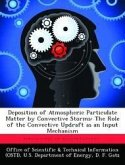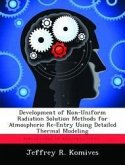There are a number of analytical and semi-empirical models that describe the behavior of particulate matter in the atmosphere. Many of these require modification for all types of weather, dry versus wet deposition, and overall effects can be quite non-linear. Rainfall (rate, drop size, etc.), snowfall (rate, flake size, etc.), humidity, pressure, temperature, and combination of these greatly affect particle settling and washout rates. To that end, a method for tracking released constituents using the Regional Atmospheric Modeling System (RAMS) microphysics package is developed by modifying one of the hydrometeor categories (hail) in the microphysics package. The RAMS microphysics package allows the investigator to change the formulation of the parameterization scheme of the model for different applications, such as a regional-scale numerical study versus a small continental cumulus simulation. In this study, four test simulations are conducted, two with precipitation and two during dry conditions, each with two different mean particle sizes.
Hinweis: Dieser Artikel kann nur an eine deutsche Lieferadresse ausgeliefert werden.
Hinweis: Dieser Artikel kann nur an eine deutsche Lieferadresse ausgeliefert werden.








